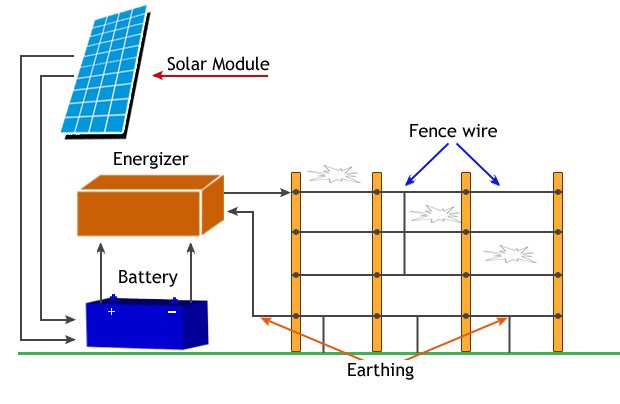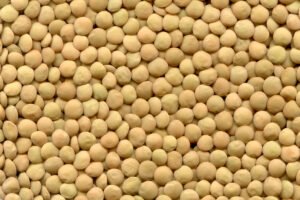How To Do Solar Power Fencing for Crop Protection?
Solar Power Fencing for Crop Protection
Agriculture is considered to be the backbone of the economy as it meets the food requirements of the people and produces several raw materials for various Industries, but because of the interference of animals in the agricultural lands, the loss of crops can be seen as crops are vulnerable to wild animals. Therefore, it is very important to monitor the nearby presence of animals.
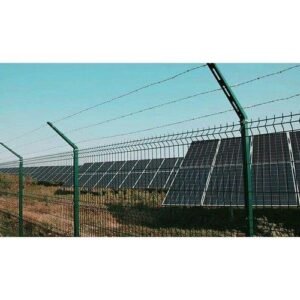
Protected Farming Guide For Beginners.
A number of alternatives has been practised by the farmers and the government to protect the crops from wild animals but none of them assures 100% success in protecting the crops. A new technique of Power fencing has been seen as an ultimate solution for protecting the crops from the animals because the solar powered fence electrifies the fence with pulsating current and these pulses are ‘shocks’ that are felt by the animals when they touch the electrified fence. Unlike conventional fences, electric fences are Psychological barriers for those animals who are trying to harm the crop so that they learn to respect the fence.
Today, we will learn about Solar Power Fencing Technology in this article but before that let’s see the other practises that the farmers follow for protecting their crops.
Different Practises of Crop Protection
The following measures are taken in the state for protecting the crops from monkeys or wild animals:
- Manually guarding the fields – Farmers deploy labours during day and night in their fields for protecting their crops where farmers use crackers or gun fires to scare away the animals but the cost of labour is very high due to the shortage of labour in the state.
- Crop Diversification – To avoid crop damage from monkeys, many farmers have changed their pattern of cropping by planting new crops like aloe vera, ginger, garlic, turmeric, medicinal and aromatic plants which are not consumed or damaged by monkeys.
- Sterilising Monkeys to control Population – The forest departments are leading innovative programs for monkey sterilisation so as to control the ever increasing population of monkeys.
How to do best Aeroponic Farming?
Solar Power Fencing Technology
Fencing is not a new concept in Agriculture. It is an old process that is carried out in different ways and methods over generation. Before fencing, it was common for the domesticated livestock to roam in the farm freely but their growing population forced the farmers to fence their animals.
It is a one time investment and provides long-term protection for farmland and property and helps in reducing crop damages due to a variety of destructive causes. For fencing, you can use a variety of materials depending upon the area of fencing, the location and the type of animal that you want to capture.
In Early times, fences were made of stone or wood but there are many options available nowadays for wire and electric fencing.
The solar power fence is like a barbed wire fencing having multiple strands of plain wires and posts made of metal or cement or wood for holding the strands in position.
These wires carry high voltage current which gives a sharp, short and a non-lethal shock to the Intruder and creates a psychological fear against any tampering.
The system is incorporated with an alarm that gets activated and alerts the inmates of the protected area. These are tailor made fences and they can be designed according to the needs of the customer and the site condition.
Best farming method for Tomato.
The system can be understood by the following diagram below:
Working of Solar Power Fencing System

The Solar Panel is made up of a number of photovoltaic cells that are connected in series and electricity is generated by these cells. They are combined to a solar panel where they produce enough voltage to charge a regular 12 volt battery and the Solar Panel ensures that the battery remains charged during all the times.
The battery powers the energizer 24 hours a day which transforms the Low Voltage current from the battery to High Voltage current upto 10000 volts and sends it to the electric fence.
By this way, the fence gets electrified and the animals receive shock due to this high voltage current on touching the fence. This keeps the animals away from the fence and thus the field is protected.
How to do disease and pest management in organic agriculture?
Advantages of Solar Power Fencing
Solar power fencing has a number of benefits that are stated as under:
- Human and Animal Safety – The electric shock is completely safe and is non-lethal for humans and animals. The current is pulsating and it passes at every 1 to 1.2 seconds and the animal gets enough time to get away from the fence. The current does not grab the animal and human and even if the animal gets trapped, after 10 consecutive shocks, the system will activate the alarm so that the nearby farmer can come to free the animal. Also, a warning board is placed at 10 metre intervals as a precaution to the humans about power fencing and if someone cuts the fence wire, a security alarm will sound to alert the farmer.
- Lower Cost – The Electric fencing requires less setup and material than the conventional fences and animals are less likely to damage these electric fences as they don’t touch it more than once, so it reduces the maintenance cost as well.
- Ease of construction – It is relatively simple and easy to build and it can be installed quickly with minimum tools, thereby, saving time and money.
- Flexibility – The wires spacing and the design of the fence can be modified to control a variety of animals.
- Long life – These electric fences can last for up to 40 years when they are built with quality components and material.
- Assurance of protection – The electric fencing assures maximum protection from the wild animals and monkeys.
How to do water management in organic agriculture?
Performance in Winter & Rainy season
Solar fencing performs effectively during all the Seasons if they are designed appropriately but the success of the solar panel totally depends on the design because the design is going to be implemented as the final solution.
It is important that the location has ambiance light otherwise the fencing system may not work properly and in such areas where snow is accumulated on the ground, it is recommended to construct fencing on a brick wall or a 1 to 2 feet fence is constructed with wire mesh fencing.
It can increase the cost of fencing but it is the only option. If required, additional power source from AC current can be provided during design itself so as to ensure seamless operation of the system.
Effectiveness during the Night & Alert system
The Solar fence runs on a battery where it gets charged by the Solar Panel and in case of 24 hours fence operation, the battery and solar panel is appropriately sized. The alarm unit accompanies the system for any Intruder detection.
Components of a Solar Power Fence
The different components of a Solar Power Fence are:
- Solar Panel – The Solar Panel converts the solar light into electricity and transfers it to battery for storage. In general, solar panels have a life of 25 years and at the end of 25 years, the power output of the panel reduces to 80%. This causes the battery to get less current and therefore it gets switched off.
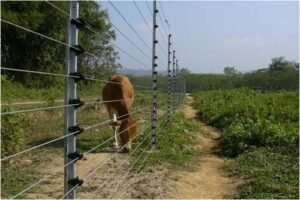
How to do crop planning in organic agriculture?
The correct size of the panel is determined by following factors:
- Current take-off of the energizer – Larger energizers draw more current and require large battery or battery tanks, so a larger solar panel or multiple panels are required for maintaining battery charge.
- Pulse speed or Power setting of the energizer – The faster the pulse speed, the more current the energizer draws and therefore a larger panel will be required.
- Daily solar radiation conditions – The amount of sunlight depends upon the geographic location of the Solar Panel and the time of year, therefore a larger solar panel is required in an area that is having less useful sunlight hours and also during winter time when sunshine hours are less.
- Required period of operation – If the energizer is required to operate during winter season also then the battery and solar panels are designed in such a way that it could be able to maintain the desired output in these lower sunlight levels.
However, the Solar Panel size is designed such that it charges the battery fully in the available sunshine hours and the provided weather conditions.
- Battery – The battery stores the power that is generated by the Solar Panel and supplies this power to the energizer. The size of the battery is selected in such a way that it could suit the electrical current consumption of the energizer that is being used and it should have enough storage capacity that it could provide power to the energizer even during the period of reduced sunlight. Usually, More than one battery is selected so that it could supply enough charge and storage capacity and this is called a ‘battery bank’. Batteries are available in two types. One is basically a C20 rated battery which are the UPS batteries and the other type is specifically designed for solar application which are C10 solar batteries. The life of the battery depends upon the amount of current that goes inside the battery and amount of current that is coming out of it. C10 batteries normally have a replaceable warranty of 5 years.
- Energizer – Energizer transforms the Low Voltage current from the battery to High Voltage current which is then sent to the electric fence. The voltage requirement varies based on the type of animal that is to be kept away. However, most of the animals can be kept away with a voltage of 6000 to 7000 Volts.
Best method to convert your farm into organic farm.
While selecting an energizer it is important to consider these factors:
- The type of area that is to be fenced
- The size of the area to be fenced
- The total length of the wire that is to be electrified
- The type of fence (single or multi wire fence)
Remember that 1 joule of output energy will power 10 kilometres of single wire fence.
- Earth System – The current produced by an energizer must complete a full circuit. When the current leaves the energizer, it should move along the fence wires through the animal, into the soil and back to the energizer via the earth system and if the earth system is ineffective, the animal will receive an inadequate shock. The earth system in an electric fencing consists of a number of earth rods that provide an effective low resistance path for the current that could return to the energizer’s earth terminal. Larger energizer with a large fence line requires more earthing rods. The type of soil, the mineral content, the ground moisture and also the fence load determines how many Earth rods are going to be required. In an electric fencing system, the earth system is the most important component and an effective system will optimise the performance of electric fencing.
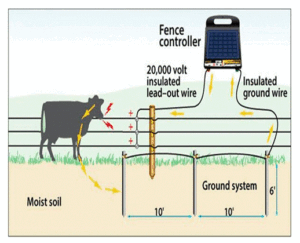
There are two types of earthing systems that are practised in the country. They are:
- Fence Wire Return System – It is practised where soil is not conductive. Here, the fence is constructed using both live and Earth wire. When the animal touches the livewire, the current flows through the animal and the ground back to the earth rods. This system of fencing is also practised so as to keep the monkeys away who touch the fence without touching the ground, preventing them from completing the electric circuit. When the monkeys cross the fence, they can touch two wires and in this way it will complete the circuit and they will receive shock.
- Ground Earth Return System – It is generally practised where the soil is conductive and is suitable for most of the moist soils. The current flows through the animal and the ground back to the earth rods.
Installation of the Solar Power Fence
A good installation of Solar fence includes:
- Proper grouting of end and corner post so that it gets the required strength.
- The vegetation along the fence should be cleared so that it prevents any energy drain.
- Aesthetic layout of fence.
- Tight joints
- Proper electrical connections
- Testing of fence
The corner posts are installed first and a temporary wire is drawn between the end posts to align the intermediate posts. Insulators are installed near to the post so that wide gaps are not left for the animals to get into the fence easily.
How to do green house farming?
The installation requirements of a solar power fencing are:
- The solar power fencing systems can be installed with existing fences except for the barbed wire as it could trap the animals.
- The solar power panels should face North-South directions to get maximum exposure to sunlight.
- The system must meet the National and International standards and use appropriate fencing tools and accessories during the installation and maintenance.
- The Earth system is an important component in solar power fencing and it should have a high performance.
- Install a good number of earth kits and it should have a built-in charger and backup battery.
- The voltage on the fence should be regularly checked at 2-3 points and it should be between 5 and 10 Kilovolt. If the voltage is less than 5 kV, the fence line should be checked for shorts or improper connections.
- The battery should be kept in an upright position and before installation, the battery should be initially charged.
- The Solar energizer should be tested by ETDC, the government of India and it should be kept in a safe place and protected from rain, severe storms and lightning.
- Do not connect the energizer to the AC mains or directly to the charger or solar
- The plant’s growth should be checked regularly.
- The Solar fence should work effectively during the night and alert systems.
Best tips for the hydroponic farming.
Maintenance of the Solar Fence System
Solar fencing requires minimal maintenance, however, regular checks should be ensured for reliable performance. To maximise the life and performance of solar fencing system, some points should be considered:
- The Solar Panel should be cleaned with a soft, damp cloth to remove residues or dust particles. If snow is accumulated on the panels, it should be cleaned properly to maintain the system in operation.
- The mounting bracket should be checked that it is secure and the tilt angle should be correct, and if required, the angle should be changed to accommodate the change in seasons.
- All the leads and connections should be checked that they are secure and undamaged by animals or vegetation.
- The electrolyte level in the battery should be checked properly.
- All the exposed terminals and wires should be checked for evidence of corrosion due to environmental conditions like salt or chemicals.
- If there is any debris or vegetation causing a short on the fence, it should be cleared. The vegetation also completes the loop causing the output voltage of the energizer to drop, so it is important to keep any growth on the fence line to the minimum, so that it ensures that the animal receives maximum available shock. The nearby trees around the fence can allow crossing the fence by monkeys, so it should also be cleared.
Best method for the integrated pest management.
Conclusion
Solar Power Fencing is an ultimate solution for crop protection and it is cheap and easy to install as well. The animals or humans are not harmed by these electric shocks. The animals just get aware about the electric fence and stay away to prevent themselves from getting a ‘shock’. Also, the system is designed to work 24 hours and can be easily maintained, thereby protecting the crops and causing minimum loss to the farmers.

